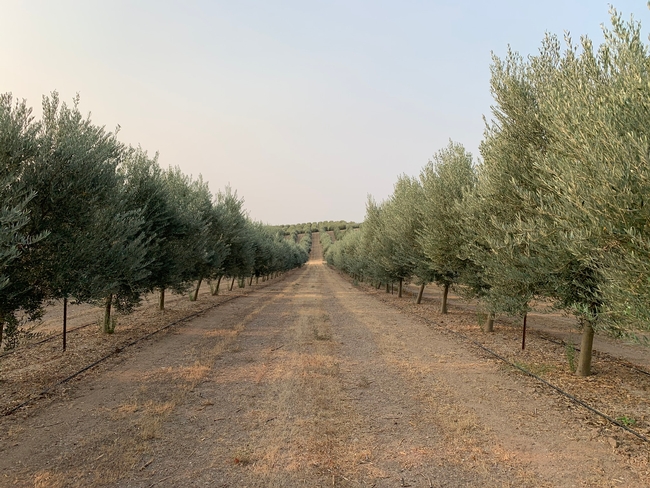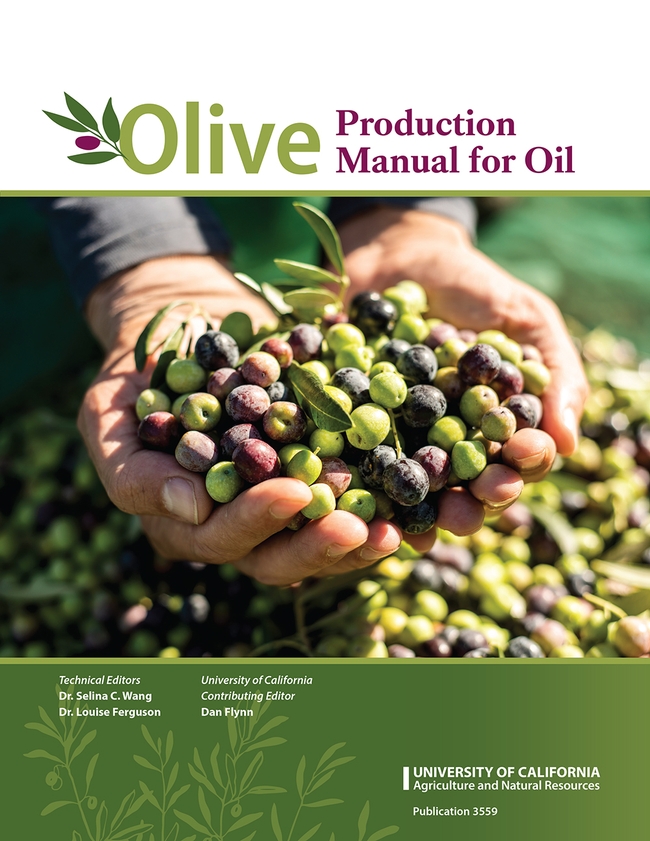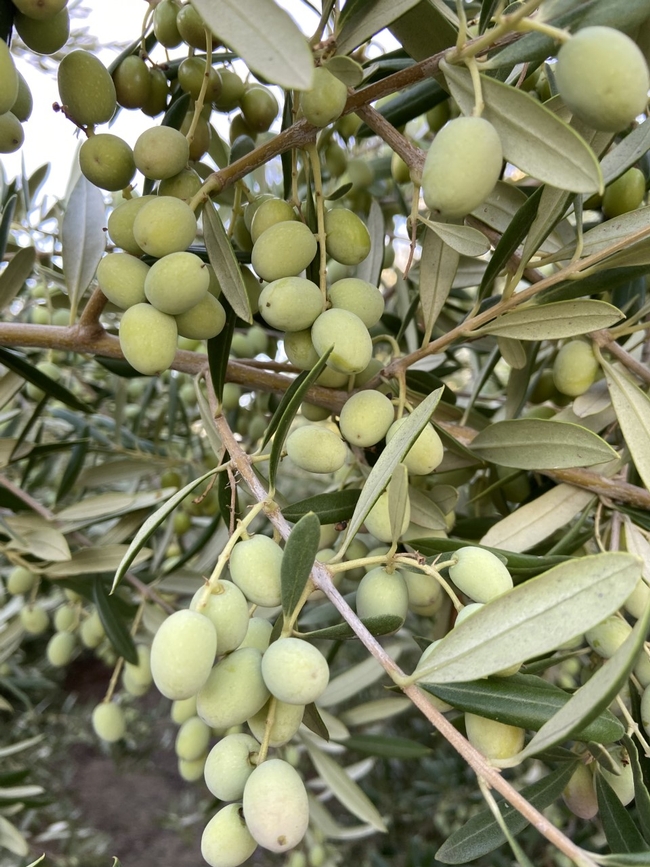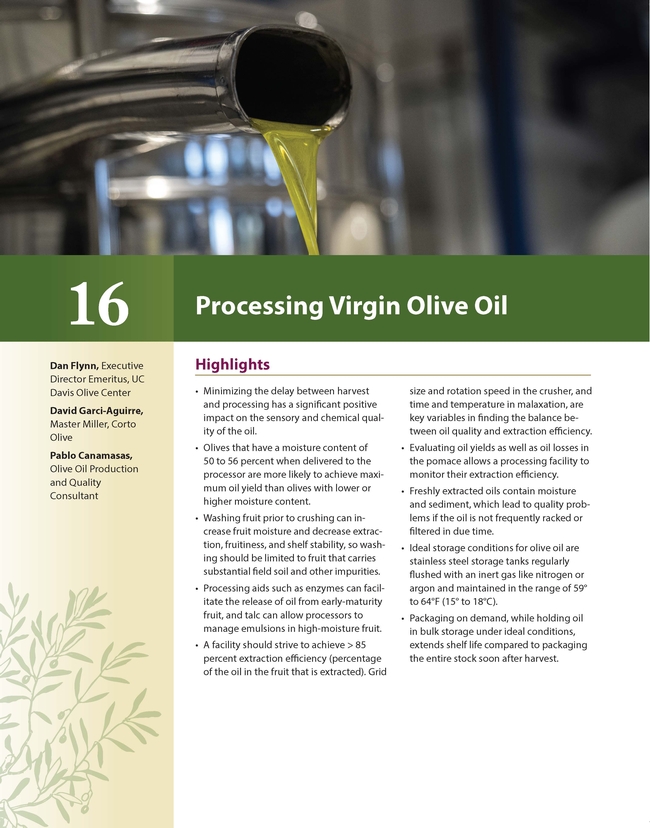
Posts Tagged: center
Yes, Hawks Eat Insects
Ever watched a red-shouldered hawk on a hunt? They eat a variety of prey, including small...

Red-shouldered hawk devouring what appears to be a praying mantis. It caught the insect in the Vacaville Museum and then perched on a telephone line to eat it. (Photo by Kathy Keatley Garvey)

UC Davis distinguished professor emerita Diane Ullman of the Department of Entomology and Nematology and Gale Okumura, Department of Design faculty emerita, in front of "A Bird's Eye View." (Photo by Kathy Keatley Garvey)
UC ANR publishes first-ever manual on olive production for oil
Growers, UC Cooperative Extension researchers offer guidance on producing high-quality olives
Facing a deluge of lower-price products from Europe, the California olive oil industry is doubling down on its clear-cut competitive edge: the consistent and bona fide quality of its oil.
“Olive Production Manual for Oil,” a new book published by University of California Agriculture and Natural Resources, aims to help California olive growers maximize that advantage.
“It's a tough market to compete in, but I think the way to win for California is to compete on quality,” said book co-editor Selina Wang, a UC Cooperative Extension specialist in the UC Davis Department of Food Science and Technology. “The quality of California olive oil is unmatched, but you can't make good quality olive oil with bad fruit, so the goal is to get more fruit from the trees – and for the fruits to be high-quality fruit.”
The 273-page manual, available for purchase online, is the first of its kind in the U.S. While some parts of the book are specific to California (which grows nearly all of the olives for domestically produced olive oil), most of the material would be useful to producers in other states, Wang noted.
“Through our conversations with growers, it became clear to us that a manual like this – not a scientific publication but a manual that is easy to follow, written in language that is accessible, and with pictures and illustrations – would be really helpful to the growers,” she said.
Growth of California olive oil industry necessitated creation of manual
Aside from a book focused predominantly on table olives and another on organic olive production (by UCCE farm advisor emeritus Paul Vossen), there was no one-stop, comprehensive resource on the bookshelf for oil olive growers. The need for such a manual had become more acute as oil olives replaced table olives in California orchards during the last 20 years.
Whereas harvesting by hand was historically cost-prohibitive, the introduction of super-high-density planting systems in 1999 made oil olive production more economically feasible. Mechanical pruning and harvesting of new cultivars (Arbequina, Arbosana and Koroneiki) – specifically bred for these densely planted orchards – led to the rapid expansion of oil olives in the state. According to a U.S. Department of Agriculture report, California olive oil production jumped from 2 million pounds in 2006 to an average of 21 million pounds in 2021–23.
With about 37,000 acres of oil olives planted across California, the Olive Oil Commission of California saw the need to support the production of this manual. Championed by Dan Flynn, founder and executive director emeritus of the UC Davis Olive Center, Wang and co-editor Louise Ferguson outlined the contents of the book. They then sought out a mix of growers and industry professionals and UCCE advisors and specialists to write its chapters.
“Most of the information is data-based, from people who are working with the olives,” said Ferguson, a UC Cooperative Extension pomologist at UC Davis. “This is the first data-based olive oil production manual we've had.”
Manual infused with firsthand insights, practical recommendations
Hard-earned experience taught growers a valuable lesson that is conveyed in the book – the need to hand-prune. While mechanical pruning helps control the size of the trees, some hand-pruning is still required to allow light to filter to the leaves. Failing to do so leads to a dramatic decrease in yield.
“That happened in many of the orchards that were inexperienced in these new cultivars and new super-high-density planting systems,” Ferguson said.
She added that other key topics in the manual include irrigation management in a water-constrained state, nitrogen management, harvest timing and orchard site selection. Choosing a good spot for planting is crucial in this era of extreme climate volatility, Ferguson noted, as olive trees are significantly affected by temperature shocks in spring (fruit set) and fall (harvest).
For Wang, another overarching theme in the manual is the importance of testing. Testing the soil, water and leaves provides critical data that growers can use to adjust their inputs and production practices for optimal profitability.
“You may spend a couple hundred dollars on the lab work, but it will pay off, for sure – you're going to increase the health and productivity of your trees,” Wang explained. “Oil olive growers are paid based on the oil content in their fruit; you not only want to have a lot of fruit on the trees, you want to make sure that your fruit are accumulating oil.”
California oil olive growers, practices continue to evolve
Wang and Ferguson hope their book will help California producers compete more effectively in the global marketplace. Currently, about 90% of the olive oil consumed in the U.S. is imported from Mediterranean countries, due primarily to the lower price point. In that region, producers tend to harvest riper olives that produce oil at a greater volume but lesser quality.
In contrast, California growers harvest earlier and produce oil that is higher quality (with more flavor and more antioxidants) and far exceeds accepted standards for “extra virgin olive oil.”
According to Wang, California olive oil mills have nearly maximized their efficiency, and the growth opportunity for the industry is in the orchards: to optimize practices to produce more fruit, and to plant more trees. Wang said the new manual can help on both fronts.
“Just like for other crops, focusing on quality – while increasing efficiency and productivity, and therefore profitability – is the name of the game,” she said.
Ferguson also stressed that knowledge continues to evolve and urged growers to reach out to the editors and chapter authors with their experiences.
“Most of the authors are in California and they're working,” she said. “So if you start to notice things that are different, or you want more information or something is not clear, the authors are available.”
The manual can be purchased at https://anrcatalog.ucanr.edu/Details.aspx?itemNo=3559.
Silk Textile Displays Grab Attention at Bohart Museum's Moth Night
"Silk is a natural protein fiber, some forms of which can...
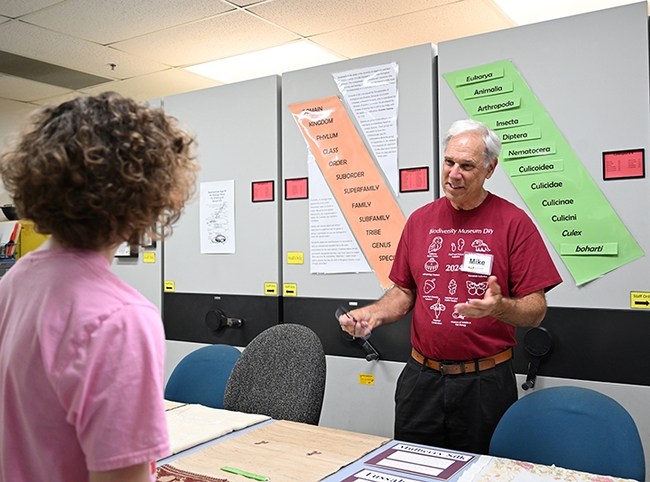
Bohart Museum associate Michael Pitcairn, retired from the California Department of Food and Agriculture, answers questions about silkworm moths and textiles. (Photo by Kathy Keatley Garvey)
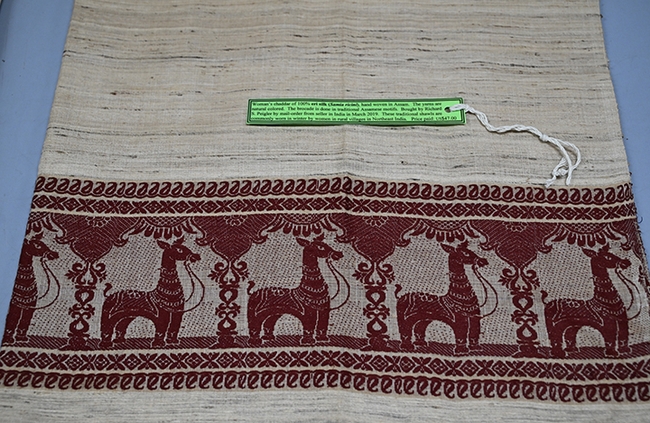
This chaddar is made of rri silk (silkworm moth, Samia ricini) and handwoven in Assam, India. (Photo by Kathy Keatley Garvey)
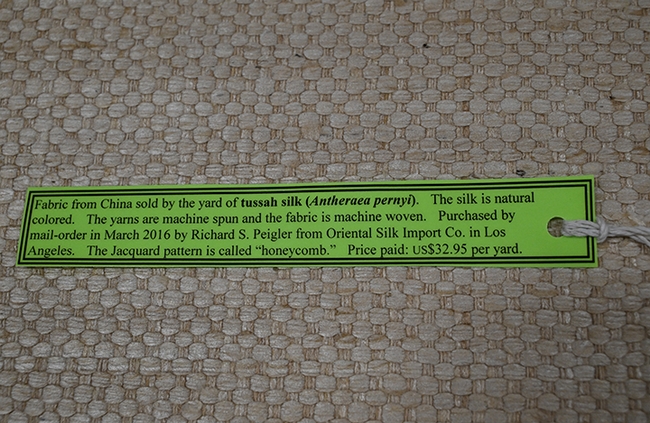
This is tussah silk fabric in a pattern called "Honeycomb." Donor Richard Pleiger purchased this fabric from a Los Angeles company for $32.95 per yard. There are several species of tussah silk moths (family Saturniidae) in China, India, Japan, Africa and North America.(Photo by Kathy Keatley Garvey)
Postharvest Center: New research focus and outreach
Still providing the world with top-notch information
UC Davis has been a leading source of information for people handling, packaging and transporting crops since the beginnings of the Postharvest Research and Extension Center in 1979. Now, the center is strengthening its focus on the needs of industry, offering fresh courses, weaving strategic partnerships and expanding into digital media, all while building up its research capacity to better serve the needs of the produce industry.
“We're asking people in the industry, ‘How can we support you? How can we better listen to you?' We want people to know we're not disconnected know-it-alls,” said new center co-director Bárbara Blanco-Ulate, an associate professor in the UC Davis Department of Plant Sciences. “We're getting more faculty involvement, people with expertise in related fields such as quality engineering and safety, as well as bringing in emeriti faculty and people from around California. We're forming partnerships with organizations around the world, and we've opened up to people from other institutions around the country.”
“The larger the network, the more things we can do,” added fellow co-director Irwin R. Donis-Gonzalez, an associate professor of UC Cooperative Extension in the Department of Biological and Agricultural Engineering.
The foundation: Expanded research
The new co-directors will beef up the center's applied science component with the hiring of a research specialist. They aim to provide new information that can be used industry-wide as companies explore new ways to handle and store fresh produce.
“We're building the capacity to respond to industry requests for research,” Blanco-Ulate said.
New courses, national reach
Their first workshop, held recently, demonstrates the center's renewed vision and commitment to broad networking: The Agricultural Water Systems Workshop addressed current concerns around water management and risks to food safety. Partners in the course included the Western Growers Association, the University of Arizona, the University of Florida and Salinas-based Taylor Fresh Foods, Inc.
Courses given over the past several years that have been recorded will be posted to the center's new, online video library and to the center's YouTube channel.
“People can watch those courses for free,” Blanco-Ulate said. In addition, new courses will be offered in-person and hybrid.
The co-directors are working with the University of California to offer continuing and professional education credits to course participants.
Online resources – many for free!
The center's website features a database with scores of free product fact sheets, which are downloaded by users around the world. The fact sheets are so highly regarded that they are considered expert evidence in legal proceedings, Blanco-Ulate said. Visitors to the website can also find links to research papers published by UC Davis faculty, including seminal works by Adel Kader, who founded the center.
Books are offered through the center's online bookstore and include titles through UC Agriculture and Natural Resources. Ten new titles are being planned, including topic-specific updates taken from previous classics.
Debunking myths: Ethylene
A new newsletter deals with a new problem: Misinformation about food and food handling that spreads through social media. One example is the use of ethylene to ripen produce such as bananas, so that they can be safely stored until ready for the consumer.
“Ethylene is safe for humans and does not leave any harmful residue on produce,” Donis-Gonzalez wrote in the center's latest newsletter. Even better news, he added: The levels of ethylene used on food are a tiny fraction of the concentrations that would be needed to create an explosion, one of the false alarms being raised in social media.
Evolving with the times
After 47 years of service, these and more updates will keep the center at the forefront of an evolving postharvest world. The top goal: Meet the needs of agriculturalists, industry and consumers.
“We are adapting to new needs, with both the resources and the workshop we're offering,” Donis-Gonzalez said.
“As a land-grant institution, we take our outreach mission seriously,” Blanco-Ulate added.
Related links
More about the UC Davis Postharvest Research and Extension Center.
This story first appeared on the UC Davis Department of Plant Sciences site.
CLBL Event on May 15: UC Davis Medical Entomologist to Discuss Natural Mosquito Control
Being bothered by mosquitoes and troubled about the risk of diseases? Mosquitoes are not just...
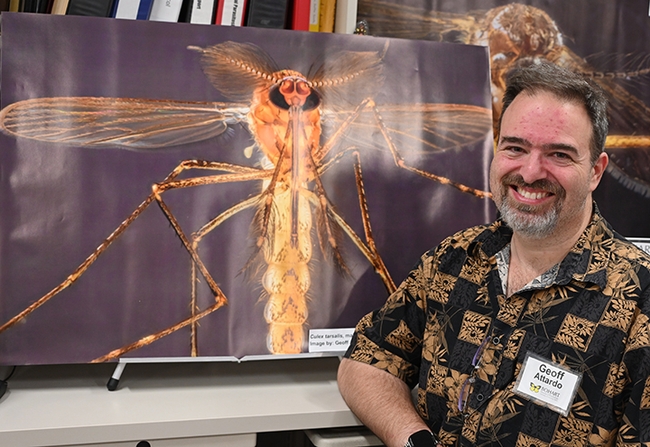
Medical entomologist-geneticist Geoffrey Attardo will present a May 15th seminar sponsored by the Center for Land-Based Learning, Woodland. (Photo by Kathy Keatley Garvey)

